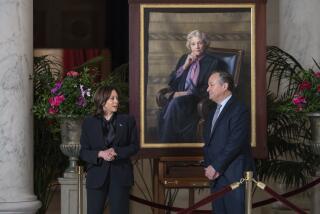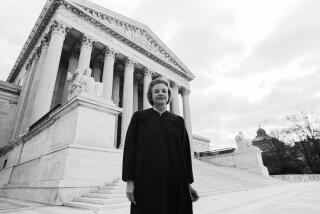Roe Is Still the Issue, but the Question Is: When Will Five Say So?
- Share via
In its decision Monday in Webster vs. Reproductive Health Services, the Supreme Court should have reversed Roe vs. Wade. Why it failed to do so is the puzzle.
The reason Roe should have fallen is Roe itself.
Contrary to the opinion of Justice Harry A. Blackmun in that case, there is no constitutional right to privacy that encompasses a woman’s liberty to have an abortion. The Constitution doesn’t express such a right nor can one be inferred from it. Nor can it be found in the history of the Constitution or the values of the American people as they have been expressed in legal codes.
These and other difficulties with the court’s original abortion decision have been thoroughly canvassed since 1973, and there seem to be at least four justices unwilling to invoke the usual doctrine of judicial inertia by which even a wrong decision is allowed to stand.
The four are quite ready to throw Roe onto the scrap pile of erroneous Supreme Court decisions. They need a fifth. And there is a fifth--Justice Sandra Day O’Connor--who plainly has problems with Roe but is shy about taking dead aim at the target.
In his concurrence, Justice Antonin Scalia does not hide his impatience with O’Connor, taking her to task and then some. Yet one wonders: Why is she reluctant?
In her concurrence, O’Connor makes much of the court’s tradition of only addressing the specific questions brought before it. The specific question of validity of Roe, she said, was not before the court in Webster. And “when the constitutional invalidity of a state’s abortion statue actually turns on the constitutional validity of Roe vs. Wade,” she advises, “there will be time enough to re-examine Roe.” And, she adds, “to do so carefully.”
Carefully? What does she mean? It is hard to know.
It is evident--it has long been evident--that O’Connor is uncomfortable with the “trimester framework” elaborated in Roe. But it is possible to be dissatisfied with that framework and yet not to disagree with the Roe majority that abortion is a constitutional right. It is possible, in other words, to perform a “careful” re-examination of Roe that does not result in a jettisoning of the abortion liberty but a refashioning of the court’s rules about the protection of that liberty at various stages of pregnancy.
This is where O’Connor may be. If so, there are four and only four votes for overturning Roe.
Yet is is obvious that there are five votes for sustaining the kind of state law upheld in Webster, and O’Connor cast one of them.
The Missouri statute so stringently regulates the abortion right that it led, of course, to the case at hand. If O’Connor is sanguine about the Missouri law, then her view of the abortion right, while obviously not the same as that of Justice Blackmun, is, well, what? Perhaps some day she will tell the nation--carefully.
Meanwhile, as Scalia wryly noted in his concurrence, he and his colleagues “can now look forward to at least another term, with carts full of mail from the public and streets full of demonstrators.”
This is no way to treat a Supreme Court. But then again, what the court did in Roe vs. Wade was no way to treat the abortion issue. And it is the court’s decision that has caused the bitter division and precipitated the abiding effort to contain and diminish the abortion liberty--an effort clearly boosted by the Webster ruling.
The court cannot end this division, but it can and should resolve the insistent question of what it thinks, on second thought, about the validity of its original abortion decision. Its inability to do so suggests that the court is about as divided on the jurisprudence of abortion as the nation is on abortion policy itself.
More to Read
Get the L.A. Times Politics newsletter
Deeply reported insights into legislation, politics and policy from Sacramento, Washington and beyond. In your inbox twice per week.
You may occasionally receive promotional content from the Los Angeles Times.










